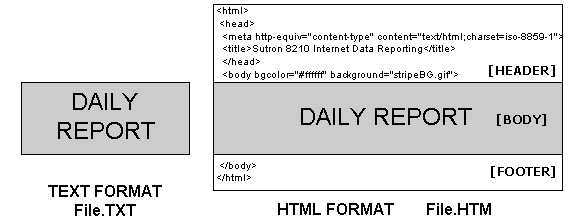| Daily Report Formats and File Types |
| The Daily Report generation is a function of the Data Logger. The Report can be as simple as stringing out raw ASCII Data with no formatting. This is not desirable to an end user who would have to manually parse the Data. A better method for a report is to add formatting so the Report Data is in an acceptable format. You build the format to best suit the end user's needs. To do this you usually have to write some sort of formatting algorithm. This algorithm is in the form of a program that resides in the Data Logger. The Sutron 8210 supports an on board Tiny BASIC Interpeter and the ability to execute modest programs written in Tiny BASIC. Our program consists of a Data gathering process, a Data formatting process, and a Data output process. The end result is a usable Report that is stored in the ICADDY until it is sent to the ISP.
The ICADDY can send out the Report as any type of file attachment. One of the ICADDY setup parameters will specify the output file type. The most common file types being Text [.TXT] or HTML [.HTM]. The easiest type of report format type is the Text File. Text files consist of simple ASCII characters and do not have any special encoding requirements. However, in a Web environment where the end user is using a browser to view the Report, the text format leaves a lot to be desired. A better method for viewing data in a Web environment is to have the Report in an HTML format. The only problem with this is the additional requirements of the Data format. As indicated in the figure below, the Report can become an HTML document with the addition of a few lines of code in the beginning of the document [HEADER]. |

| The Report [BODY] remains the same for both .TXT and .HTM file types. The HTML format file requires a [HEADER], [BODY], and [FOOTER] sections to make the file HTML compliant. If the end result of the Report is to be a HTML file that resides on a Web Server - the name of the file becomes an issue. By design, the ICADDY will name the Report file with a combination of the Site Name and Report Date. An example of this is the name 'CANALx013002.HTM'. The Site is CANALx, the Date is 30 JAN 02.
Our user may not know the naming conventions of the file. We may not want him to know the naming connventions either. To solve this problem will require an INDEX page on the Server with JavaScript to re-direct the browser to the correct page. The question of how you want your Report to go out to the end users will determine the format of the Report. TXT or HTML ? HTML format on a Web Server will require more work but will be more accessable to your end users. If the E-mail option of the ICADDY is used the number of end users is limited to ten. Something to think about. Top Back |